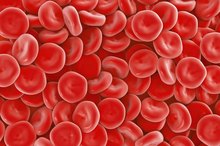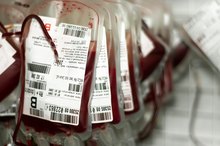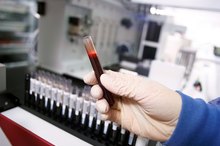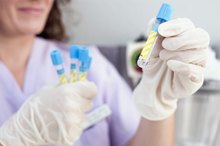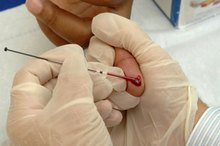5 Things You Need to Know About Thick Blood Disease
There’s a saying that “blood is thicker than water,” but blood that is too thick can be a serious medical issue. Although uncommon, there are some disorders that cause thick blood -- including those that lead to an abnormally high number of blood cells and conditions that cause hypercoagulation, or excessive blood clotting 3. These disorders can lead to serious, life-threatening consequences, so early detection and treatment are important.
If you are experiencing serious medical symptoms, seek emergency treatment immediately.
Excess Blood Cells
Certain diseases, namely blood cancers, thicken the blood because they lead to abnormally high levels of blood cells. While rare, one of the more common reasons for thick blood is called polycythemia vera (PV), in which the body produces excessive blood cells -- mostly too many red blood cells. PV is caused by a genetic mutation and typically develops slowly, over several years.
Waldenstrom macroglobulinemia is a type of non-Hodgkin lymphoma, or blood cancer, that causes overproduction of an antibody -- a type of blood protein -- called immunoglobulin M. Myeloma is a blood cancer caused by abnormal and uncontrolled growth of plasma cells -- a type of white blood cell that produces antibodies 5. These conditions can also cause thick blood, crowding the blood with abnormal antibodies, leaving too few of the infection-fighting antibodies.
- Certain diseases, namely blood cancers, thicken the blood because they lead to abnormally high levels of blood cells.
- These conditions can also cause thick blood, crowding the blood with abnormal antibodies, leaving too few of the infection-fighting antibodies.
Excess Clotting
Can You Eat Certain Foods to Lighten Thick Blood?
Learn More
When you suffer a wound or cut, your body forms a blood clot to stop the bleeding -- a process called coagulation. The clot is formed from blood proteins called fibrins and platelets, or cell fragments. Typically, your body breaks down the clot. However, sometimes blood clots form too easily or do not dissolve properly. This excessive clotting -- hypercoagulation -- also causes thick blood 3. This can be dangerous since clots can form inside your blood vessels and block blood flow to tissues or organs. Hypercoagulation may be caused by genetic disorders or it may be associated with acquired conditions such as certain autoimmune diseases and cancers, pregnancy or certain medications.
- When you suffer a wound or cut, your body forms a blood clot to stop the bleeding -- a process called coagulation.
- This can be dangerous since clots can form inside your blood vessels and block blood flow to tissues or organs.
Health Effects
Thick blood flows more slowly than normal blood, which deprives body organs and tissues of the amount of oxygen required for necessary function. Side effects include headaches, dizziness, fatigue, itchiness and vision problems. High levels of abnormal white blood cells can cause anemia, tiredness, weight loss, bone pain and frequent infections. Most seriously, people with thick blood -- whether from excessive blood cells or hypercoagulation -- are at high risk for clots that block or limit blood flow to vital organs. The possible consequences include a stroke, heart attack or serious damage to other organs such as the kidneys or lungs.
- Thick blood flows more slowly than normal blood, which deprives body organs and tissues of the amount of oxygen required for necessary function.
- Most seriously, people with thick blood -- whether from excessive blood cells or hypercoagulation -- are at high risk for clots that block or limit blood flow to vital organs.
Medical Treatment
Diseases That Cause Low Red Blood Count
Learn More
Many people are not diagnosed with these conditions until later in life. However, sometimes these disorders are uncovered by routine blood tests, through personal or family medical histories or when a doctor is investigating the cause of early symptoms such as tiredness or anemia. Depending on the severity and underlying cause of thick blood, there may be ways to correct the disorder or reduce the risk of related complications. Phlebotomy -- the removal of some blood -- or medications are treatments aimed at reducing blood cell numbers. Blood thinning medications such as warfarin (Coumadin) can reduce clotting. Consultation with a physician specializing in blood disorders will determine the best course of action for your specific condition.
- Many people are not diagnosed with these conditions until later in life.
- Depending on the severity and underlying cause of thick blood, there may be ways to correct the disorder or reduce the risk of related complications.
Warnings
Most importantly, immediate medical care is needed if a blood clot, stroke or heart attack is suspected. A blood clot in the leg can cause redness, pain, warmth and swelling in the lower leg. A heart attack or a blood clot in the lungs or heart can cause:
- shortness of breath
- chest pain
- chest heaviness or pressure
- discomfort in the neck
- jaw
- upper back or arms
Symptoms of a stroke include difficulty speaking or understanding speech, headaches or paralysis that is typically on one side of the body. These symptoms require emergency medical care to determine the cause and receive live-saving treatment as soon as possible.
- Most importantly, immediate medical care is needed if a blood clot, stroke or heart attack is suspected.
- A heart attack or a blood clot in the lungs or heart can cause: * shortness of breath
* chest pain
* chest heaviness or pressure
* discomfort in the neck
* jaw
* upper back or arms Symptoms of a stroke include difficulty speaking or understanding speech, headaches or paralysis that is typically on one side of the body.
Related Articles
References
- National Heart, Lung, and Blood Institute: What Is Polycythemia Vera?
- National Heart, Lung, and Blood Institute: What Are the Signs and Symptoms of Polycythemia Vera?
- American Heart Association: What Is Excessive Blood Clotting (Hypercoagulation)?
- Annals of Hematology: Current and Future Treatment Options for Polycythemia Vera
- Leukemia and Lymphoma Society: Waldenström Macroglobulinemia Facts
- American Society of Hematology. Blood Clots.
- Litvinov RI, Weisel JW. What Is the Biological and Clinical Relevance of Fibrin?. Semin Thromb Hemost. 2016;42(4):333-43. doi:10.1055/s-0036-1571342
- American Heart Association. Understand Your Risk for Excessive Blood Clotting.
- Adivitiya, Khasa YP. The evolution of recombinant thrombolytics: Current status and future directions. Bioengineered. 2017;8(4):331-358. doi:10.1080/21655979.2016.1229718
- Fields JM, Davis J, Girson L, et al. Transthoracic Echocardiography For Diagnosing Pulmonary Embolism: A Systematic Review And Meta-Analysis. J Am Soc Echocardiogr 2017; 30:714. doi:10.1016/j.echo.2017.03.004
- Gibson NS, Schellong SM, Kheir DY, et al. Safety And Sensitivity Of Two Ultrasound Strategies In Patients With Clinically Suspected Deep Venous Thrombosis: A Prospective Management Study. J Thromb Haemost 2009; 7:2035. doi:10.1111/j.1538-7836.2009.03635.x
- National Blood Clot Alliance. Signs and Symptoms of Blood Clots.
- Weitz JI, Fredenburgh JC, Eikelboom JW. A Test In Context: D-Dimer. J Am Coll Cardiol 2017; 70:2411. doi:10.1016/j.jacc.2017.09.024
Writer Bio
Doug Dohrman earned a Ph.D. in neuroscience from the University of Iowa. Following post-doctoral training at UCSF, he directed courses in neuroscience and histology for first year medical students and has also taught in anatomy, physiology and biostatistics. His research background is in cell and molecular biology and he is currently involved with medical editing/writing.

